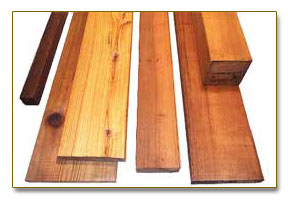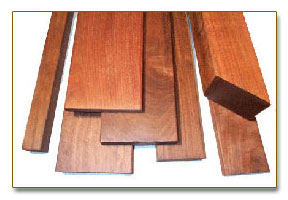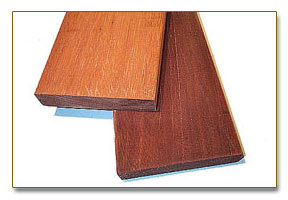Wood has a warmness and a beauty that's just about impossible to duplicate in any man-made product. Today's highly crafted decks use some of the most extravagant Hardwood and Softwood species of lumber. From Ipe to Clear Cedar, decks built with wood still remains the most popular choice.
Many wood decks will actually have a combination of several different species of wood used in its' construction. Its' not uncommon to see a Clear Cedar railing used with Ipe or Mahogany decking. The combination of wood is sometimes used to keep cost down as well as to enhance the overall appearance of the deck. You can see a variation of this in some homes with wood in-laid floors and highly crafted furniture.
Note: Building departments will often require that the substructure be constructed from pressure treated lumber regardless of the species of wood used for the decking and railings.

Pressure Treated ( Southern Yellow Pine )
The most popular choice of deck materials in the US, primarily because it is long-lasting and the most economical. About 80% of pressure treated wood is Southern yellow pine, although other plentiful local species are used in some areas. Grain patterns are prominent; its initial greenish color becomes a honey brown before fading to gray. It is available in nearly every lumber outlet – in various grades and in common lumber dimensions plus 5/4 (spoken five-quarter) decking profiles. Tags stapled on the ends of lumber indicate the intended use, e.g., above ground or ground contact. Some dealers carry material that contains built-in water repellent or is re-dried after treatment.The chemical preservative is forced into the wood cells under pressure. Pressure treated wood usually has a warranty against decay and termite damage, in most cases for the lifetime of the original purchaser. Preserved lumber is also used for fencing, landscaping, walkways, and other backyard projects.

Western Red Cedar
Newly cut cedar has a color range from light browns and tans to salmon pink. Left untreated it will eventually turn silvery gray and then to a very dark brown. It's graded A, B, C, or D.This soft wood is more durable than most woods in common use. It is resistant to decay, but relatively soft and quick to weather. Preservative treatment/sealing is recommended

Redwood
Redwood is available in several grades which vary considerably in appearance and quality. The color will vary from a light red to a dark reddish-brown. It's graded in Clear Heart, B-Grade, Construction Heart, or Construction Common.The clear heart grade is the more durable than the other redwood grades because of its high resistance to decay. This is the grade that redwood has received its reputation on. Redwood is a soft wood and weathers to a yellowish-red very quickly.

Ipé, Iron wood, Paulope... (Imported Hardwoods)
Ipéis Portuguese for hardwood. These are extremely dense, tight-grained woods. Ipé color ranges from red-amber hues to dark brown. Some brands are more consistent as a dark brown. These woods are virtually clear from knots. These imported, tropical hardwoods have a very high rating for insect and decay resistance, similar to pressure treated. These woods will turn silver gray very fast. These hard woods are very difficult to work with because they all need to be pre-drilled before screwing and nailing or they will split. Expect to pay extra dollars a square foot for labor to install these hard woods because you triple the time for installation.
Mahogany
Honduras mahogany is a true mahogany. There are other species like "Philippine Mahogany" that try to take the well-known name. True mahogany has a woven look to the grain with a courser texture.Not all mahogany has the resistance to decay needed for outdoor use. The medium to dark red and brown species are more resistant to decay.